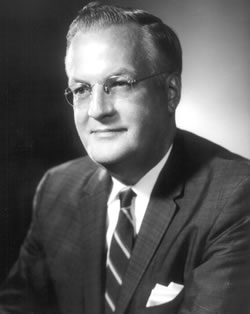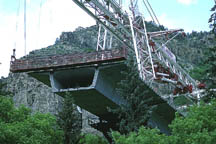STRUCTURAL ENGINEERING
Kavanagh Lecture - Biographical Sketch
The Thomas C. Kavanagh Memorial Structural Engineering Lecture

Dr. Thomas Christian Kavanagh
1912 - 1978
BIOGRAPHICAL SKETCH
Thomas Christian Kavanagh spoke of himself as a consulting engineer and an educator. He was a civil engineer, a renowned structural designer, and long before the term was invented, a systems engineer. He was a person of great vision, with superior technical ability, great optimism, energy and social consciousness; was deeply involved in all phases of his discipline, committed to engineering work, dedicated to engineering causes, a leader in the technology of engineering, and a strong symbol of the best in the profession. The Engineering Profession was his life.
At the time of his death he was a partner in the consulting firm of Iffland Kavanagh Waterbury, Engineers-Architects-Planners. The National Academy of Engineering (NAE) was close to his heart, and for the first ten years he was its Treasurer.
Thomas Christian Kavanagh was born of immigrant parents on August 17, 1912, in New York City. His father, Patrick F. Kavanagh, had come from Ireland, and was a laborer and electrical worker for one of the New York city streetcar companies; his mother was the former Anna C. Unger, who had come fro Germany. Tom was brought up in modest surroundings. Since both his brother and sister were invalids and required the better part of his parents' attention, Tom, starting at an early age, was pretty much on his own. What he became was due to his drive, stamina, and intellect. He finished high school in three years. A scholarship enabled him to buy books and to study engineering and also sent hi to Germany to the Technological University of Berlin. On the boat returning from his year in Europe, he met Kerstin E. Berglund on her way back to Cranbrook, Michigan, from her native Sweden, and married her five years later. In the meantime, Tom had worked himself through college, graduating a Phi Beta Kappa.
Kavanagh had become fluent in German and kept up with the contents of German technical magazines. He never said "no" when asked to do something for the profession. When others fell down in what was required, Tom took over. When it was necessary to criticized, he did so in a pleasant way and with a smile. He started many young people on the route to professional work and encouraged their making contributions on committees and through publications.
He had a unique ability to bridge the gap between the academic and the practitioner's viewpoints, and was held in high regard by both sides. He could translate issues and considerations peculiar to the building industry in terms understood by those on the outside. When tom explained why something was impractical, people usually understood.
Tom understood the socio-economic side of engineering--the positive and negative impacts of a proposed action---and was able to articulate it well. He was a patient listener, an effective adviser, and a good mediator. In any group, Tom stood out as a gentleman. His approach was soft and diplomatic. He did not shirk difficult assignments and was equally at home among his peers as he was among junior groups.
Tom was conscious of an engineer's duties and service to mankind; he was conscientious, through, and inventive, with a drive for improvements wherever he had any influence.
Kavanagh thought of civil engineering as the basic civilian discipline (in contrast to military engineering), the parent discipline from which spawned all the other branches of engineering. Specialties such as Ocean Engineering, in which he was interested, were part of Tom's civil engineer's world. This world Tom described as "encompassing that boundless activity directed toward fulfillment of human needs through adaptation and control of the land-water-air environment--a truly tremendous scope."
Tom Kavanagh earned B.S. and M.C.E. degrees from the City College of New York, an M.B.A. in finance, and a science doctorate from New York University (N.Y.U.). He became a structural designer, working for engineering firms in Yew York and Pennsylvania on railway and highway bridges, sanitary plants, industrial structures, transmission towers, power plants, waterfront structures, floating docks, refineries, municipal improvements, investigations, reviews, and adequacy reports. He was an aircraft engineer in World War II.
After several years as an assistant professor of civil engineering at New York University, he became a professor at The Pennsylvania State College (now The Pennsylvania State University) in 1948 and also became the head of its structures department. In 1952, he moved back to New York University and became the Chairman of the Department of Civil Engineering. In 1953, Tom started to spend one afternoon a week working with the consulting firm of Praeger & Maguire. Soon Tom joined this firm as a full partner with the firm's name changed to Praeger-Kavanagh, and later to Praeger-Kavanagh-Waterbury. However, Tom kept up his teaching activities as an adjunct professor at N.Y.U. until 1956, and at Columbia University thereafter. During this period Kavanagh was responsible for a number of outstanding projects, such as the Arecibo (Puerto Rico) radio telescope (the world's largest), the Hawkins Point Floating Bridge on the St. Lawrence River, the planning for the subway system of Caracas, work on the New York City Building Code and on design manuals for the U.S. Navy, the project for bridge crossing of Long Island Sound and many others.
In 1969, his firm was merged into URS, and this merger eventually led to Tom's separation from the company. He joined Louis Berger International, Inc., and became a vice-president managing large projects in Cyprus and Lagos. In 1976, he joined in founding Iffland Kavanagh Waterbury, a consulting firm undertaking projects similar to those which the Praeger-Kavanagh firm had undertaken.
The variety of Tom Kavanagh's activities is hard to envision. Likely no other man contributing to the work of dozens of committees, commissions, councils, or boards has made as many personal contributions on such a wide variety of subjects. He was a member of 20 professional societies. In the course of 12 years he served on 20 NAE committees. At one time or other he led 20 professional working groups; only 10 of the 20 groups he headed as chairman are listed here as examples: Committee on Ocean Engineering of NAE (this name later was changed to Marine Board), Finance Committee of NAE, Civil Engineering Peer Group of the Committee on Membership of NAE, Metropolitan Section of the American Society of Civil Engineers (ASCE), Research Committee of ASCE's Structural Division, U.S. Council of the International Association for Bridge and Structural Engineering, Committee on Systems Engineering of the Consulting Engineers Council, Commission on International Relations of the Engineers Joint Council, Ethical Practice Committee of the Consulting Engineers Council, and Committee for Coordinated Construction Activity of the Building Research Advisory Board of NRC.
He headed program committees, technical sessions, nominating boards, university advisory boards, and accreditation and educational committees. As ASCE director, he represented those members who were not residents of the U.S.A. He was a founding member of ASCE's Research Council for the Performance of Structures and for years was most active in the Column Research Council (now Structural Stability Research Council). For six years he served on NRC's Building Research Advisory Board (one year as vice-chairman). In the 1960's he served in the leadership of the Engineers Joint Council (as senior vice-president in 1971-1972).
A wide diversification of interests and a multi-disciplinary approach to engineering projects were his hallmark, as well as a strong feeling for aesthetics.
Kavanagh was the author of over 100 technical publications. He received recognition and awards from professional societies and agencies too numerous to list. As examples: an honorary engineering doctorate from Lehigh University, the Ernest E. Howard Award of ASCE for his contributions to the advancement of Structural Engineering, the David Steinman Medal for Structural Engineering from the City College of New York, and the Gold Medal of the architectural League. He was an Honorary Life member of the New York Academy of Sciences. He became a Junior Member of ASCE in 1933, an Associate Member in 1947, a Member in 1952, was accorded Fellow in 1959, and became a Life Member in 1978.
During the 1970's he was most active in the Council on Tall Buildings and Urban Habitat. As a charter member of the Council's steering group, he touched everyone's thinking as he strongly urged the "systems approach" and the need to recognize the broader aspects of the impact of high-rise buildings. The lives of Tom and Kerstin were enriched during these years by their world-wide travels to attend meetings of the council.
Leaders within the American Society of Civil Engineers inquired in 1977 whether Thomas Kavanagh would be available to take on the ASCE Presidency for the term starting October 1978. However, his active role as an officer in a consulting firm as well as all his other commitments forced him to decline this position.
It is only natural that Tom Kavanagh was a driving force among the 25 engineers, representing a broad spectrum of the profession, who in 1964 created what became known as The National Academy of Engineering. He was elected a member of the Council of the new Academy. Tom was very much concerned with the quality of new members of the Academy and exerted his influence through those who were appointed to the Committee on Membership. His interest in improving the mechanism of the selection and election process continued when he served on the Membership Committee.
When NAE President Robert C. Seamans resigned in 1974 to accept the U.S. president's appointment to a government position, Thomas Kavanagh was chairman of the search committee for a new president of the Academy. Tom's committee came up with Courtland D. Perkins as its candidate and convinced Dr. Perkins to accept the nomination as president; his election followed in 1975. With this selection, Thomas Kavanagh left his last imprint on the Academy.
Based on abstract of a memoir prepared by Anton Tedesko, Hon. M. ASCE; Jerome S. Iffland, F. ASCE; and Michael N. Salgo, F. ASCE, as published in Transactions, American Society of Civil Engineers, Vol. 144, 1979.

